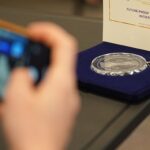International investors are increasingly turning their backs on Central, East and Southeast Europe. This is the conclusion of a new report by the Vienna Institute for International Economic Studies (wiiw) on foreign direct investment (FDI) made or pledged in the region.
In the first three quarters of this year, the number of greenfield investment projects announced plummeted by 44 per cent, compared to the same period last year.
Although the amount pledged for direct investment shrank less sharply, it still fell by a whopping 39 per cent. The number of investment projects announced in the EU member states of the region and the six Western Balkan states also fell by over 40 per cent, compared to the previous year.
“The crisis in German industry and geopolitical uncertainties are now making their full impact felt on the region,” explains Olga Pindyuk, economist at wiiw and author of the report.
In any case, the data show a significant slowdown in new foreign greenfield investment in most countries of the region: only Moldova registered an increase. Among the EU member states, Bulgaria, Poland and Estonia have seen the most swingeing cuts, with commitments halved.
In Albania, which is still experiencing a boom due to tourism, the number of greenfield investment projects has plummeted by as much as 88 per cent.
Nevertheless, eight countries recorded a higher inflow of foreign capital than last year. These are led by Estonia, Lithuania and Kosovo. That the investments pledged in Montenegro, Ukraine and Bosnia and Herzegovina shrank faster than the number of projects indicates that the structure of investment is changing in favour of less capital-intensive service projects.
Austrian investors cautious, German investors on the retreat
Investment commitments from Germany have slumped particularly sharply: they fell by around 44 per cent, from 171 to 96 projects announced, and by 67 per cent in terms of capital pledged, dropping from over nine billion euros in the first three quarters of 2023 to only around three billion euros in the same period this year.
Austrian companies, traditionally important investors and business partners in the region, have also significantly pruned back the number of projects announced in Eastern Europe (from 34 to 15, compared to the same period last year); but they have pledged to invest 20 per cent more money than last year (965 million euros, compared to 804 million euros in 2023). However, this is still around 80 per cent less than in 2022.
Romania, Hungary and Bulgaria are the countries set to benefit the most from Austrian investments. “While we are seeing German investors turning away from Eastern Europe and towards the US, Austria remains strongly committed to Eastern Europe and will probably continue to invest more there than in the US, despite the various economic problems,” believes Pindyuk.
China dominates new investment
Despite a decline, China remains the largest investor in newly pledged investments across Central, East, and Southeast Europe, ahead of Germany. While Germany’s investment, measured in terms of capital pledged, fell by 67 per cent, China’s declined by only 30 per cent.
However, the share of Chinese FDI stocks in total FDI stocks in the region is only around one per cent, while stocks from EU countries amount to around 70 per cent, according to the wiiw FDI database.
While Hungary in the EU and Serbia in the Western Balkans were until recently the largest recipients of Chinese direct investment, this year Romania holds the top spot in terms of the number of projects, while Slovakia is in line to receive the largest amount of Chinese capital pledged.
The state-owned Beijing car manufacturer SAIC wants to produce electric vehicles in Slovakia. What is striking is the high capital intensity of Chinese projects, which mainly stem from commitments to car and battery projects: their value exceeds that of German projects by a factor of eight.
The study suggests that the slump in Central, East and Southeast Europe could go much deeper over the course of the year. This is because the decline in investments announced was even more dramatic in the third quarter, when global uncertainty increased in the run-up to the US presidential elections. With a drop of 70 per cent from July to September, they reached their lowest level for four years.
“Apparently, investors seem to have had even less confidence in the third quarter of 2024 than at the height of the Covid-19 pandemic or after Russia’s large-scale invasion of Ukraine,” says Pindyuk.
Investors turning to the US
With the outgoing US government’s Inflation Reduction Act and the high energy prices in the EU, the countries of Eastern Europe appear to be facing fresh competition from America for foreign direct investment.
The number of Chinese greenfield projects in the US did fall from 47 to 41 in the period January-September 2024, compared to the previous year, while the number of German projects also fell – from 162 to 138. However, these figures significantly exceed the number of projects announced in Central, East and Southeast Europe, where only 28 projects from China and 96 from Germany were announced.
The reorientation of German investors towards the US becomes even clearer when one looks at the investments announced.
Whereas the capital pledged for greenfield projects in Central, East and Southeast Europe was 40 per cent higher than for projects in the US in the period January-September 2022, the amount committed to the US in the same period of 2024 was almost three times the amount pledged to Central, East and Southeast Europe.
Structural change away from the ‘extended workbench’ model
The long-term development of FDI in the region (2010-23) indicates a structural change in many countries, particularly in Central Europe. Slovakia, for example, which is dominated by the automotive industry, put in the region’s worst performance in terms of FDI inflows from 2020 to 2023 in relation to GDP: it was able to attract even less foreign investment than Russia, which is subject to far-reaching Western sanctions.
As Pindyuk comments, “This is a further indication that the growth model of Central Eastern Europe, which is based on attracting foreign direct investment, may have had its day.”
In several studies, wiiw has repeatedly pointed out that the concentration on production and manufacturing—i.e. the ‘extended workbench’ model for Western companies—will be inadequate to secure or increase prosperity in the long term.
It therefore advises the countries of the region to invest more in education, research and development, as well as to come up with a well thought-through, tailored industrial policy.







